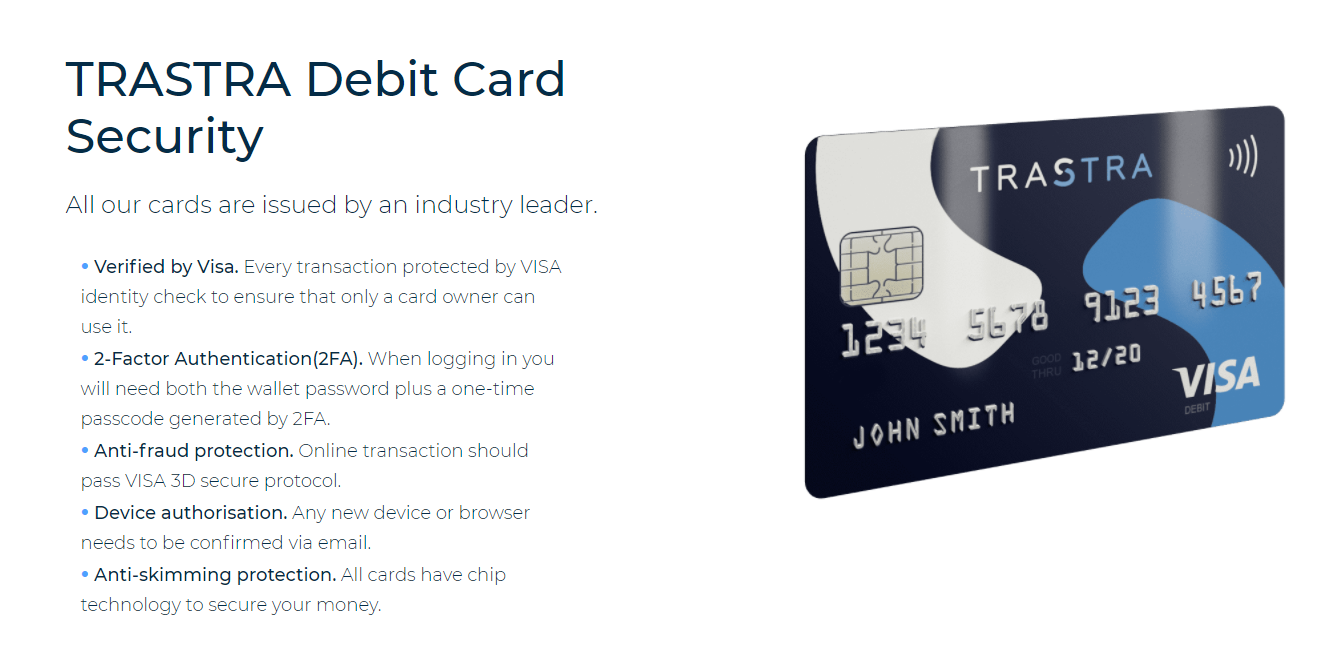
TRASTRA
カードの手数料
ファンディング方法
仮想通貨 (7)
TRASTRA Review
A common argument for regular money (also known as fiat currency) as opposed to cryptocurrency is that you can’t use cryptocurrency to buy groceries and other everyday items. Well, through the use of a cryptocurrency debit card, you can. This is a review of TRASTRA, one of the crypto debit cards out there.
General information
TRASTRA is a very interesting new card that we at Cryptowisser.com are very excited about. At the moment, it is only available to people from the European Economic Area, so if you're from the EEA (or not from the EEA but still interested), this review will be very exciting to you.
TRASTRA seems to focus a lot on simplicity. It is a VISA-card, meaning that you can use the card at any point of payment that accepts VISA. This is of course a great advantage, seeing that VISA is the most widely accepted card in the world (alongside MasterCard).
You can deposit funds to the card in many different ways. For instance, wire transfers and SEPA transfers (for countries in the SEPA-zone) is no problem at all.
Referral Program
TRASTRA also offers an attractive referral program. The terms are quite simple, you invite friends, and when your friends order cards or exchange cryptos etc, you are rewarded. You get 5 EUR for a TRASTRA Payment Card activation by each friend you invite, and you receive 0.20% of the total volume of your friends' exchanges.
Supported Cryptos
The card has support for six of the biggest cryptocurrencies: Bitcoin, Bitcoin Cash, Ethereum, Litecoin, Ripple and USD Coin.

TRASTRA Fees
TRASTRA’s fees are very competitive. There are of course fees involved in using it, but these are not deterrent to using it at all.
There is a low monthly fee, only EUR 1.25 a month. There is an issuance fee set to EUR 9.00. This is slightly below the global industry average crypto debit card issuance fee which is arguably around USD 15.00.
Over then to ATM-fees. Balance inquiries will set you back EUR 0.35 and a PIN-change will cost you EUR 0.40. The actual withdrawal fees are EUR 2.25 if you withdraw EUR or withdraw from inside the EEA. On the other hand, if you withdraw another fiat currency than EUR or withdraw from somewhere outside the EEA, you will have to pay EUR 2.25 + 3% of the withdrawn amount. Fixed fees like this may become disadvantageous in countries where the normal ATM-machines only allow smaller amounts of withdrawals (EUR 20 for instance). In such scenarios, in order to withdraw a larger amount you need to withdraw several times, thus triggering the fixed fee each time. You can usually avoid this by just going to a local bank at the relevant place. Local banks normally permit higher withdrawals.
Furthermore, the most important fee of them all, is the commission on spending. TRASTRA doesn't have a spending commission at all for online and offline purchases in EUR. This is a very competitive feature for this card and it is actually quite unusual. For non-EUR card purchases, there is a spending fee amounting to 3.00% of the transaction value. So, clearly a more beneficial offering when it comes to EUR-purchases.
There are no maximum or minimum deposit limits at all.
TRASTRA Security
TRASTRA also seems to take security very seriously. Among other things, the card is protected by VISA identity check, you can enable two factor authentication, there's anti-fraud protection and device authorisation requirements. What else could you possibly need?
Concluding remarks
We have a great feeling about the TRASTRA Payment card. You can order one here.
If this is the cryptocurrency debit card for you, congratulations. But if not, check out one of the other cards in our crypto debit card list.
Good luck!